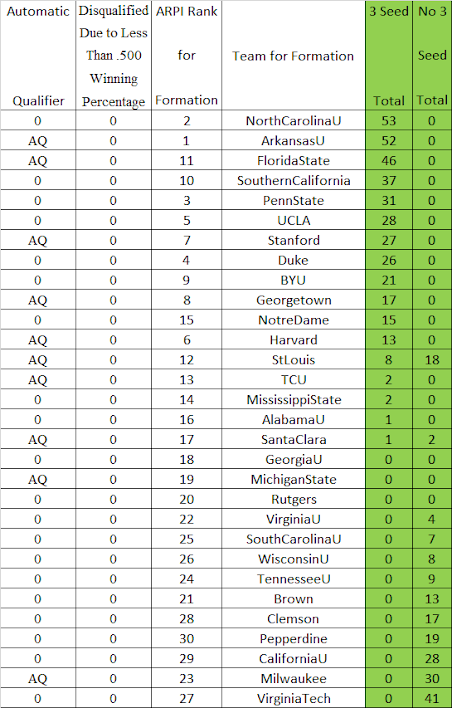This is my second weekly report for the 2023 season. Each week I show:
1. Teams’ simulated ranks using the current NCAA RPI and my Balanced RPI;
2. Based on the current NCAA RPI, teams in candidate pools (expanded) for NCAA Tournament #1, 2, 3, and 4 seeds and for at large selections and where they appear to fit within the pools; and
3. Likely differences in at large selections for the NCAA Tournament if the Women’s Soccer Committee were to use the Balanced RPI rather than the current NCAA RPI.
The background for the information is in 2023 Reports 1 through 4.
Each week, I replace my simulated results for the previous week with actual results. So this week’s information is based on actual results of games played through Sunday, August 27, and simulated results of games not yet played.
Summarizing the likely differences in at large selections for the NCAA Tournament in changing from the current NCAA RPI to the Balanced RPI, derived from the last table below:
At Large Candidate Teams: 10 teams that are not at large candidates under the current NCAA RPI are candidates under the Balanced RPI. Of these, 4 are from the West, 4 from the South, and 2 from the Middle regions. 8 are from Power 5 conferences and 2 are from mid-majors.
No Longer Candidate Teams: 10 teams that are candidates under the current NCAA RPI are not candidates under the Balanced RPI. Of these, 5 are from the North, 4 are from the South, and 1 is from the Middle. All 10 are from mid-major conferences. Of these, all either are Automatic Qualifiers or likely would not get at large selections under the current NCAA RPI.
Selected Teams: 4 team that likely are not at large selections under the current NCAA RPI likely are at large selections under the Balanced RPI. Of these, 2 are from the West and 2 from the South. All 4 are from Power 5 conferences.
No Longer Selected Teams: 4 teams that likely are at large selections under the current NCAA RPI likely are not at large selections under the Balanced RPI. Of these, 2 are from the North and 2 from the South. All 4 are from mid-majors.
The basic change pattern is that teams dropped from the at large candidate pool either are Automatic Qualifiers or likely are not at large selections under the current RPI, so they are not hurt by a change to the Balanced RPI. But of the teams added to the candidate pool under the Balanced RPI, some likely are at large selections, displacing teams that are at large selections under the current NCAA RPI. Thus the effect of the defects in the current NCAA RPI is to prevent teams that deserve at large selections from even being considered by the Committee, with the result that less deserving teams are getting at large selections.
Simulated Ranks
(ARPI 2015 BPs is the current NCAA RPI; URPI 50 50 SoS Iteration 15 is the Balanced RPI)








No comments:
Post a Comment